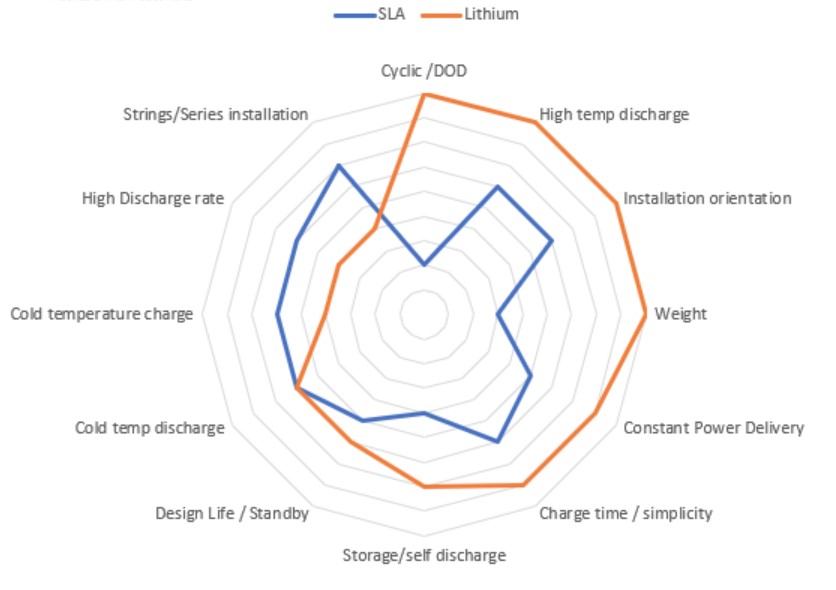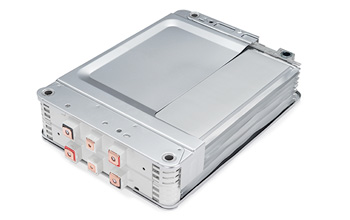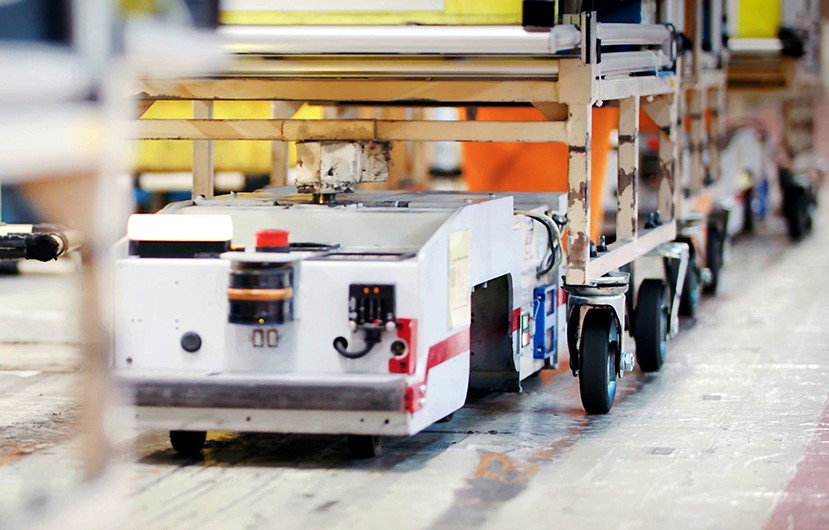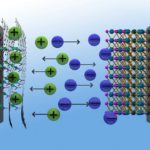Batteries are the most common power source for mobile robots. In today’s designs, lead-acid batteries have been mostly replaced by lithium chemistries. The two most common lithium chemistries in these applications are variations on lithium-ion (Li-ion), and lithium iron phosphate (LiFePO4). This FAQ will begin by comparing the performance capabilities of Li-ion and LiFePO4 batteries. It will then look at current efforts to use recycled electric vehicle (EV) batteries as the prime power source for automated guided vehicles and logistics robots and conclude with the possible use of zinc-air batteries as structural components in future generations of mobile robots.
Li-ion and LiFePO4 offer designers performance tradeoffs that make them suitable for specific types of applications. Li-ion has an energy density of 150 to 250 Wh/kg compared with LiFePO4, with an energy density of 90 to 120 Wh/kg. Li-ion and Li-polymer batteries have voltages from 3.6 to 3.85V, depending on the chemistry and design. LiFePO4 has a lower voltage of 3.2V, which contributes to the lower energy density of these batteries.
The chemistries have similar charge rates of about 1C. But the discharge capabilities differ significantly. Li-ions are typically limited to maximum discharge rates of 1C. Li-polymer batteries can support somewhat higher discharge rates but still can’t approach the capability of LiFePO4. At high discharge rates up to 25C, LiFePO4s have voltage discharges that are excellent even when operated at higher temperatures.

Lithium iron phosphate vs. sealed lead acid battery performance. (Image: Power-sonic)
There are significant cycle life differences between Li-ion and LiFePO4. Li-ion has a cycle life of 500 to 1,200 cycles and can be negatively impacted when operated at higher operating temperatures. LiFePO4 has a rated cycle life of 1,000 to 10,000 cycles and can withstand high temperatures with minimal degradation.
Both Li-ion and LiFePO4 have good long-term storage characteristics. LiFePO4 has a slightly longer shelf life of 350 days compared with about 300 days for Li-ion.
Safety advantages of LiFePO4
Li-ion batteries are more energetic (have a higher operating voltage rating) and have higher energy storage capacities than LiFePO4 batteries. Those performance advantages are also one of the sources of Li-ion’s safety disadvantages. High energy density results in lower battery chemistry stability. And it can result in heating faster during charging, resulting in thermal runaway.
When safety is a significant concern, especially with larger format batteries found in mobile robots, LiFePO4 can be the preferred chemistry. LiFePO4 has very good thermal and chemical stability. It is inherently non-combustible and is resistant to thermal runaway since the phosphate cathode will not burn or catch fire during overcharging or overheating.
LiFePO4 batteries are also easier to recycle or dispose of once their useful life has ended. Lithium cobalt dioxide chemistries of Li-ions are classified as hazardous materials and can cause allergic reactions to the eyes and skin when exposed. It can also result in serious medical issues if swallowed. As a result, Li-ion batteries require careful disposal. LiFePO4 batteries are non-toxic and easy to handle and dispose of as needed.
Finally, LiFePO4 batteries, with their relatively benign chemistry, can generally handle harsh industrial environments such as elevated temperatures and shock and vibration better than Li-ion batteries. That can also make LiFePO4 a good choice for many mobile robot applications.
Recycled EV batteries power robots in the EV factory
Used Li-ion and LiFePO4 are replacing the lead-acid batteries used in automated guided vehicles (AGVs) and some logistics robots. Nissan and 4R Energy have partnered to recycle used lithium batteries from Nissan LEAF EVs for various uses, including powering AGVs and logistics robots in the factories that make LEAF EVs. A first-generation LEAV includes a 24kWh battery back that contains 48 8-cell battery modules. It takes three of those 8-cell battery modules to power an AGV. As autonomous logistics robots replace the AGVs in the future, those robots will be powered with recycled LEAF battery packs.

Nissan LEAF 8-cell Li-ion battery module. (Image: Nissan)
Using recycled lithium batteries to power AGVs or logistics robots brings multiple benefits: The lithium batteries charge faster than the lead-acid batteries they replace. And the lithium batteries do not need to be removed from the vehicle for recharging. The rapid charging capability of lithium batteries enables AGVs and mobile robots to recharge each time they stop momentarily to pick up or deliver components. That saves time and reduces costs. Compared with the lead-acid batteries that needed to be replaced every two years, the recycled LEAF batteries will last up to eight years.

Nissan AGVs with recycled Li batteries from LEAF electric vehicles. (Image: Nissan)
The recycling process at the 4R Energy factory begins by disassembling the battery packs and testing each module. The modules are graded from “A” to “D”. The highest performance modules, graded “A”, can be used in battery packs for EVs. The “B” graded batteries meet the performance requirements of forklifts, AGVs, logistics robots, and other applications, including stationary energy storage installations in commercial and residential environments. Grade “C” modules are used in less demanding backup power applications where the backup power is only needed occasionally and for a limited amount of time. Packs rated “D” are not useful as batteries and are disassembled and recycled for their materials. Recovered batteries can live up to 15 years, depending on the demands of the application. Even with an extended life of only a few years, recycling EV batteries can significantly reduce their overall carbon footprint.
Structural batteries for robots
Batteries used as structural elements have been proposed for EVs and mobile robots. Recently, a group of researchers have developed a rechargeable zinc battery that integrates into the structure of a robot (called a biomorphic battery) to provide more energy with a lower weight. The use of structural batteries is expected to be even more useful in smaller robots where the use of discrete batteries results in too large or too inefficient designs. In robots, batteries account for about 20% of the volume and weight, and the percentage rises for smaller microbots. Microbots are being developed that can swarm and self-assemble into larger systems. Multifunctional structural batteries are envisioned to replace today’s batteries and free up space and reduce weight, but current structural batteries can only supplement the main battery.

Zinc-air structural battery for robots. The silver body of the robot is the battery. (Image: University of Michigan)
Today’s structural batteries cannot compare with Li-ion batteries in terms of energy density. But that may change. The proposed lightweight zinc rechargeable batteries are made with inexpensive, abundant, and largely non-toxic materials. The gel and aramid nanofibers will not catch fire if the battery is damaged. The aramid nanofibers can be obtained from recycled used body armor.
The energy density of initial rechargeable zinc batteries could double the range of delivery robots. In the longer term, the benefits could be much greater. The researchers estimate that robots could have 72-times more power capacity if their exteriors were replaced with zinc batteries than having discrete Li-ion batteries.
These rechargeable zinc-air batteries operate with hydroxide ions passing between a zinc electrode and the air electrode through an electrolyte membrane made using a network of aramid nanofibers (the carbon-based fibers found in bullet-proof vests), and a specially designed water-based polymer gel.
There’s still work to be done before commercial rechargeable zinc-air batteries find use as structural elements in robots. Cycle life needs to increase. These cells only maintain high capacities for about 100 cycles, not enough for practical applications. Two approaches are being pursued to address that limitation. Of course, work is underway to increase the cycle life. In addition, since zinc batteries are easy to recycle, work is also underway on robot designs where the structural battery components are replaced regularly. If that can be done efficiently, the robots could benefit from the 72X battery capacity increase offered by the zinc alternative.
Summary
Robot designers have a growing number of options for battery power sources. Li-ion can provide the highest energy densities, while LiFePO4 has advantages in terms of environmental ruggedness. New options are opening up, including recycled Li-ions from EVs that may provide lower-cost alternatives to new batteries. And research is underway to develop structural batteries that could lead to even higher performance energy storage systems in the future. The next FAQ in this series will consider how batteries may be replaced with fuel cells.
References:
Lithium versus lead-acid batteries, Power-sonic
Lithium-ion battery, Wikipedia
The LEAF’s lithium-ion batteries find a home in Nissan’s automated guided vehicles, Nissan
U-M Researchers Develop Battery System Within Robots to Boost Energy, University of Michigan




Tell Us What You Think!